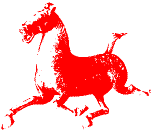
 |
||||||||||||
| malay concordance project | ||||||||||||
| home | about | papers | blogs | searching | texts | direct search | ||||||
The use and effect of pantun in the Hikayat Indraputra
The Malaysian four line poem, known as the pantun, first appeared in Malay literature in the fifteenth century (Wilkinson et al 1957) uses its first two lines as a hint to the facts that are stated in the third and fourth lines. As RJ Wilkinson says, “the first pair of lines should represent a poetic thought with its beauty veiled, while the second pair should give the same thought in all its unveiled beauty” (Wilkinson et al, 1957:3). Often the first two are nonsensical, but in the Hikayat Indraputra, a tale written some time in the 1700’s (Malaysia oldest manuscript, which possibly pre-dates even the arrival of Islam) the construction of the pantuns are very clever and tell the reader much information about the story.
In the Hikayat Indraputra, there is an episode in which Indraputra meets Princess Kemala Ratnasari and steals her flying garments while she and her nymph servants are bathing in a pool. He uses pantun to hint to the nymphs what he has done and each part of his actions is slowly revealed through the pantun. What follows are the original version, the English translation, and then my own interpretation of the meanings of these poems.
Unfortunately in the English translation, the literary qualities of rhyme and rhythm are lost. However the meanings stay essentially the same.
Original version
Apa dicari bayan terbang,
rajawali menyambar dia;
apa dicari dayang berulang,
orang bestari mendapat dia.English translation
What is sought by the flying parakeet,
the black hawk snatches it;
what is it the maids in waiting repeatedly look for
that the clever person has found.This pantun describes how Indraputra, as the black hawk, has snatched what the nymphs, or the ‘flying parakeets’ are looking for. He is the clever person who has found these things (the flying garments) that belong to the maids in waiting.
Original version
Nyiur gading tumbuh sepohon,
batangnya lemah gemulai;
buahnya sedang lambu(ng)[1]-lambungan Indraputra,
anak Raja Bikrama Bispa.The translation of lambung-lambungan as stomach, or side/flank, is insufficient for supplying a meaning of relevance to the pantun. However, a meaning is guessed in my translation of the actions described in the pantun.
English translation
The ivory coconut growing on the tree,
its stem supple and swaying;
its fruits sufficient for Indraputra’s stomach,
the son of King Bikrama Bispa.Indraputra is describing here the body of the Princess as a coconut tree, and the coconuts as her breasts. He may be hinting that her body was a pleasure to look upon when he describes the fruit as ‘sufficient’ for his stomach (which may be a metaphor for his eyes looking upon a beautiful, or satisfying sight). In the final line he gives away his identity as the son of the King.
Original version
Bunga melur kembang sekaki,
daunnya gugur melayang;
Indraputra,
anak Maharaja Bikrama Bispa.In the copy of the Hikayat Indraputra at the Bibliothèque Royale, Brussels, the line ‘Indraputra’ is written ‘tangkainya dipermain Indraputra’, which has been used to translate the pantun in order to make more sense of the language.
English translation
Jasmine flowers on one stem,
their petals fall down and fly away;
its stem became the plaything of Indraputra,
the son of King Bikrama Bispa.In this pantun Indraputra talks of the flying garments in terms of petals falling away from the ‘stem’ that is the women’s bodies. The stem becoming the plaything of Indraputra is the situation in which the Princess and her maids in waiting are now being toyed with by Indraputra through his use of pantun.
Original version
Anak gerda mudik sekawan,
seekor siripnya dilanggar duduk;
sisiknya lekat di tangan Indraputra,
anak Maharaja Bikrama Bispa.This is a particularly difficult pantun to translate, because of the terms used. Gerda, or the Garuda, referred to in the first line is a mythical bird half eagle and half man. However, the words sirip and sisik are defined in modern dictionaries as scales, which are no part of the garuda. Therefore, the translation has assumed that in traditional Malay language, either the Garuda was considered to have scales, or that these terms could also be used to describe feathers. The translation has used feathers for the purpose of making the modern translation more understandable.
The term seekor does not in this case refer to an animals’ tail. It is used as a classifier for a single animal, in this case one of the flock of young Garuda.
English translation
A flock of young garuda goes upstream,
the feathers of one of them attacked and forced to the ground;
the feathers stuck on the hand of Indraputra,
the son of King Bikrama Bispa.Indraputra finally reveals it is he responsible for the disappearance of the flying garments, which he refers to as the feathers of the garuda. After the ‘attack’ the garuda (the women) cannot fly. They have fallen off the women and come into the hands of Indraputra, son of King Bikrama Bispa.
Conclusions
The above pantuns and their interpretations and translations prove that in the Hikayat Indraputra there is extremely clever use of this traditional art form. In the story, the pantun add an element of humour and suspense to the story, improving the reader, or listeners, enjoyment.
While an English translation cannot recreate the artistic and poetic qualities of pantun, an English speaker can still appreciate the skill by reading the interpretations.
List of References
Mulyadi, SWR 1983 Hikayat Indraputra: A Malay Romance Foris Publications, Holland
Wilkinson, RJ and Winstedt, RO 1957 Pantun Mělayu The Malaya Publishing House Ltd, Singapore
1 The brackets are inserted into the Mulyadi (1983) account of the Hikayat Indraputra. They are probably added in order to make sense of the term lambung-lambungan, as lambu does not exist in modern Malay.
| top |